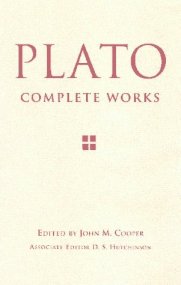Being and Becoming. What do these terms even mean for Plato? This was probably one of the most difficult ideas to wrap my mind around freshman year. I heard professors talking about it all the time, but I never could figure out what it meant. After thinking about it for a semester, I was finally able to figure it out.
Plato explains his system of existence in Timaeus. He breaks existence down into three categories: Being, becoming, and space.
Since these things are so, we must agree that that which keeps its own form unchanging which has not been brought into being and is not destroyed, which neither receives into itself anything else from anywhere else, not itself enters into anything else anywhere, is one thing. It is invisible- it cannot be perceived by the senses at all- an it is the role of understanding to study it. The second thing is that which shares the other’s name and resembles it. This thing can be perceived by the senses, and it has been begotten. It is constantly borne along, now coming to be in a certain place and then perishing out of it. It is apprehended by opinion, which involves sense perception. And the third type is space, which exists always and cannot be destroyed. It provides a fixed state for all things that come to be… We look at it as in a dream when we say that everything that exists must of necessity be somewhere, in some place and occupying some space, and that which doesn’t exist somewhere… doesn’t exist at all.
That’s a big quote and a lot of information, so let me break it down by each level of existence.

Being is the highest level of existence. These are things that never change. Since they never change, they cannot change their state of existence, meaning they could never have come into existence, they just eternally are. There present existence is their eternal existence. This is the realm of Plato’s Forms. Some examples of things that would be in the realm of being would be truth, goodness, and beauty (as one of the forms). Truth is an idea that does not change, but simply is. Truth cannot change or else the truth of the past would become un-truth and not be true at all. Truth exists in the realm of being, eternally the same. Individual truths (small ‘t’) may be change in relation to time (he is sad, he is happy), but truth itself as a form gives these statements their qualities.
Christians and readers of the Old Testament should be thinking about when God introduces himself to Moses as “I AM”. He was, and is, and is to come. He didn’t come into his godship, but is eternally God. He is unchanging and eternally existent. If Plato’s structure is correct, this is where the Christian God would be.
Becoming is a lower level of existence. It is that which is ever changing yet has similarities to those things that are Being. Man exists then passes away. The earth is continually changing. Birth, death, and new life are continually happening. Everything is coming into existence and as time continues it will continue to come into existence but never fully be being in existence. These things have a beginning and exist in time and space. The further they exist in time, the more existence they have, but they will never pass the present or exist above it. They can be sensed as they exist in the physical world. Man is continually coming into the world. Each individual is experiencing more and more of existence through time and eventually will not experience existence. Even if one has eternal life, he will eternally be-coming into that eternity. He is not eternity.
Space simply acts as a placeholder for things that are becoming. Everything that has existence in becoming takes up some sort of space or it does not exist at all. There is no second moon of earth for it does not exist in space. The dog next to me does not exist because it does not take up space. The idea of these things may exist in our imagination somewhere, but they do not take up space in the universe and therefore do not properly exist.
Plato’s structure of existence is not the easiest thing to understand, much less agree with. You first have to accept his idea of the Forms before you can really believe in Being. However, Plato’s idea of existence would continue to show up for hundreds of years in the works of great writers like Pseudo Dionysius and Augustine.

Pingback: To Infinity and Beyond: Dionysius on Being and Evil | Torrey Book Blog